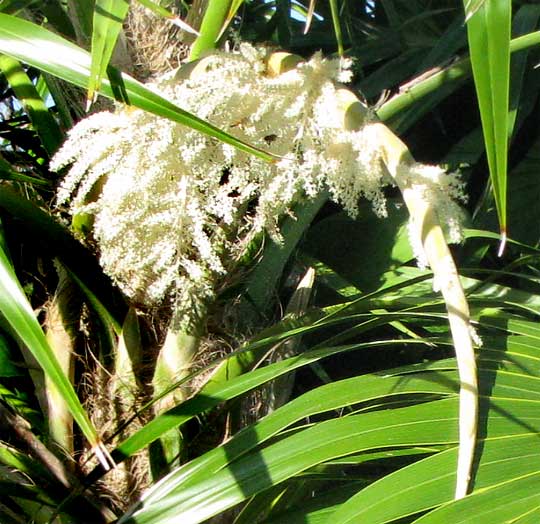Excerpts from Jim Conrad's
Naturalist Newsletter
from the June 3, 2012 Newsletter issued from the woods of the Loess Hill Region a few miles east of Natchez, Mississippi, USA
CHIT PALM/ THATCH PALM
Karen's mom not far from Natchez has two palm trees planted in her front yard, shown below:
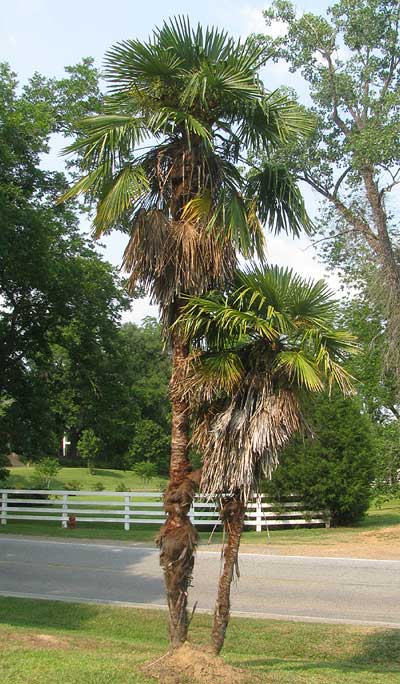
This time last year we were at Marcia's on the beach north of Mahahual on the Yucatan coast where an abundant palm, the Chit Palm, Thrinax radiata, looked a lot like this one. Our Chit Palm entry is below.
So, does Karen's mom have the Yucatan's Chit Palm growing in her front yard? The Natchez palm produces very large panicles of flowers and fruits just like the Yucatan's Chits, as shown below:
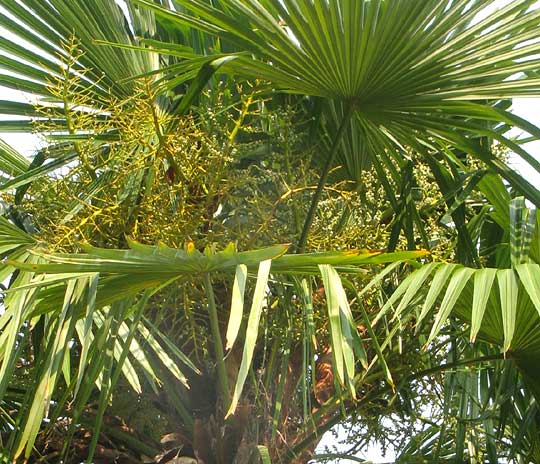
Also, remember that Chit Palm leaves bear a broad toothlike thing, the hastula, at the top of their petioles where the leaflets radiate from, as shown on our Chit Palm page. Well, look at the broad, toothlike hastulas where leaflets radiate from atop the petioles on fronds of the Natchez palm below:
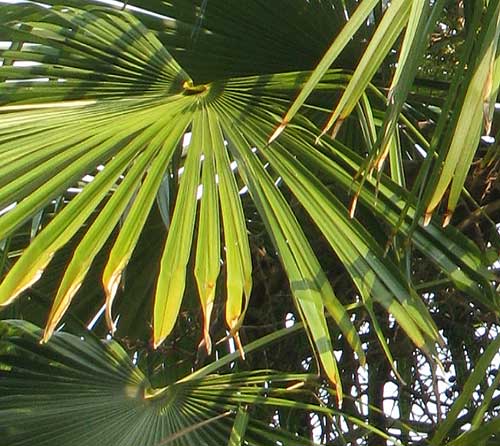
And look at the great shags of fiber covering portions of the trunk of the Natchez palms below:
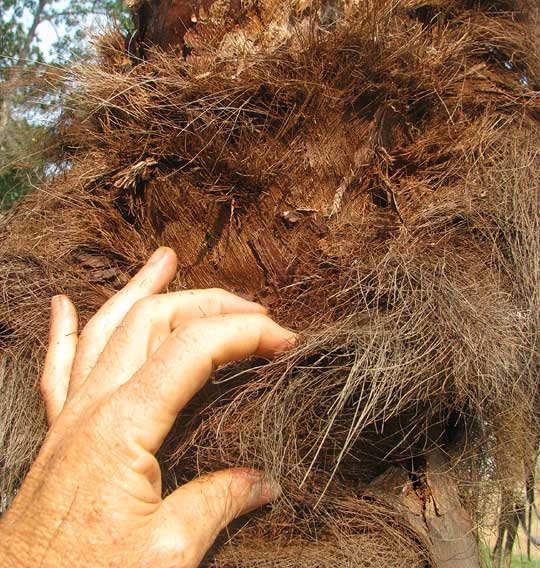
"Matted fibers" are mentioned in the literature as a feature of Chit Palms. Historical records indicate that indigenous people in the Chit Palm's distribution area made rope and fish netting Chit fiber.
Therefore, by golly, Karen's mom does have Chit Palms growing in her front yard.
Literature and websites in the US habitually refer to the Chit Palm species, Thrinax radiata, as Florida Thatch Palms. Having seen so many in the Yucatan, however, and knowing that the Maya there use a different palm, the Huano, Sabal yapa, for thatching, that name just doesn't seem right. Still, it's what North Americans call it. We'll just lop off the Florida part, and call it Thatch Palm, but always think of it as Chit.
from the December 1, 2008 Newsletter written at Mayan Beach Garden Inn on the Costa Maya, Quintana Roo, México
CHIT PALMS
Here in the much rainier, lusher southeast corner of the Yucatan Peninsula I'm seeing the abundant fan-palm shown below:
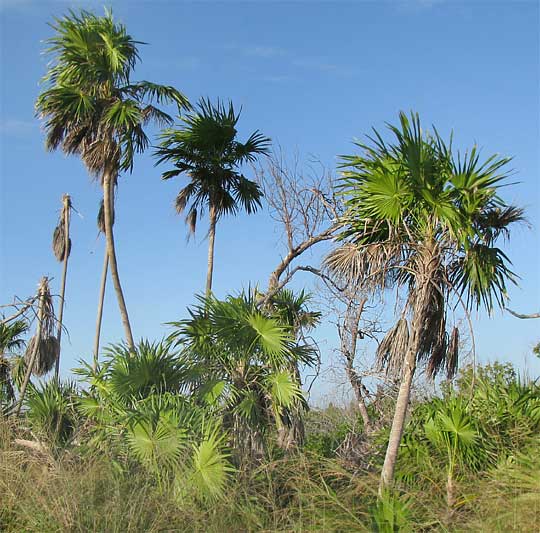
In Maya it's called Chit, but in North America often it goes by the name of Florida Thatch Palm. It's THRINAX RADIATA. When I lived in Yokdzonot my neighbor Doña Neima swept with a broom made of Chit fronds. You can see a picture from that time of the Doña and her somewhat worn broom below:
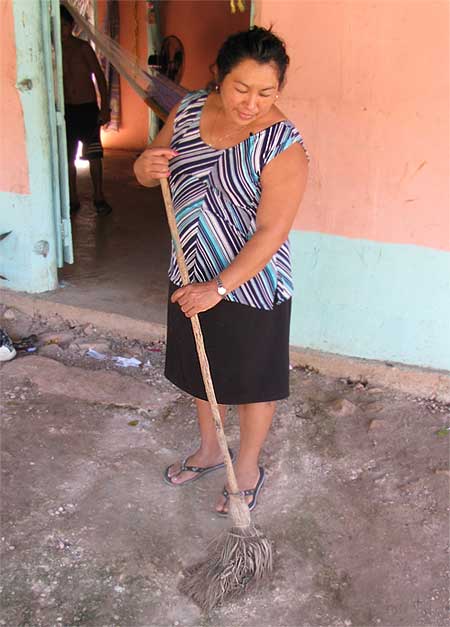
You can seeh a Chit's frond on a tree below:
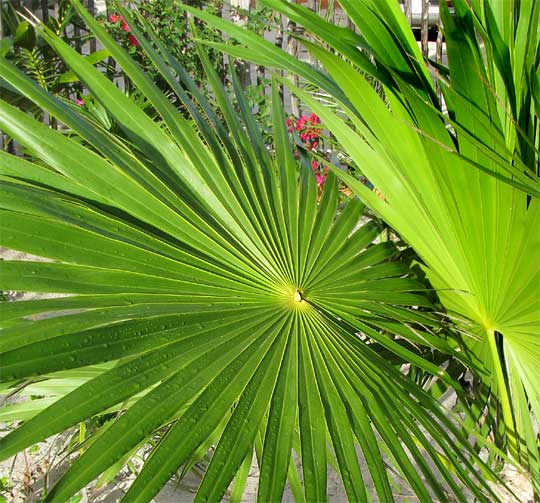 .
.
Notice how the Chit frond's petiole ends abruptly at the point where the frond segments radiate outward. Even more, at the petiole's connection point in the frond's center, notice that a toothlike growth rises perpendicular to the petiole. That toothlike item is referred to as a hastula. Hastulas occur on the fronds of several palm kinds but in the genus Thrinax hastulas are particularly well developed, and therefore they constitute a good field mark for the Chit.
Chit occurs in the Florida Keys, where it's listed as endangered, as well as throughout the Caribbean, and much of Belize and the Yucatán. In terms of land area occupied (discounting the vast stretches of sea) this is actually a fairly small distribution area. Chits are regarded as threatened in the Yucatán, which might strike you as curious if you see how prolifically Chit seeds germinate beneath standing trees.
To understand why the species is endangered, all you have to do is to look around, away from right beneath the tree. In this area Chit occupies the maybe 200- meter narrow ridge of sand between open water to the east and mangrove swamps to the west. That's also precisely where real-estate signs and scalped, occupied lots also are found. Habitat destruction and its limited distribution endanger Chit, not persnickety habitat requirements and not traditional broom-making by the Maya.
Below you see a large, white, honeybee-buzzed inflorescence of Chit flowers:
